Organizational Behavior: Article Critique on Motivation and Efficiency
VerifiedAdded on 2020/03/23
|6
|1895
|419
Report
AI Summary
This report offers a comprehensive critique of the journal article "The Effect of the Motivation Techniques Used by Managers to Increase the Productivity of their Workers and an Application" by Guclu & Gune (2017). The critique analyzes the article's thesis statement, exploring its strengths, such as its focus on efficiency and motivation techniques, and weaknesses, including the extensive introductory definitions and fragmented presentation of key concepts. The report evaluates the article's theoretical framework, research methods, and the relationship between the thesis statement and the overall discussion. It also provides suggestions for improvement, emphasizing the need for clear research objectives, a cohesive presentation of the thesis statement elements, and a more robust research methodology. The critique concludes by summarizing the article's main arguments and offering recommendations to enhance its clarity and effectiveness.
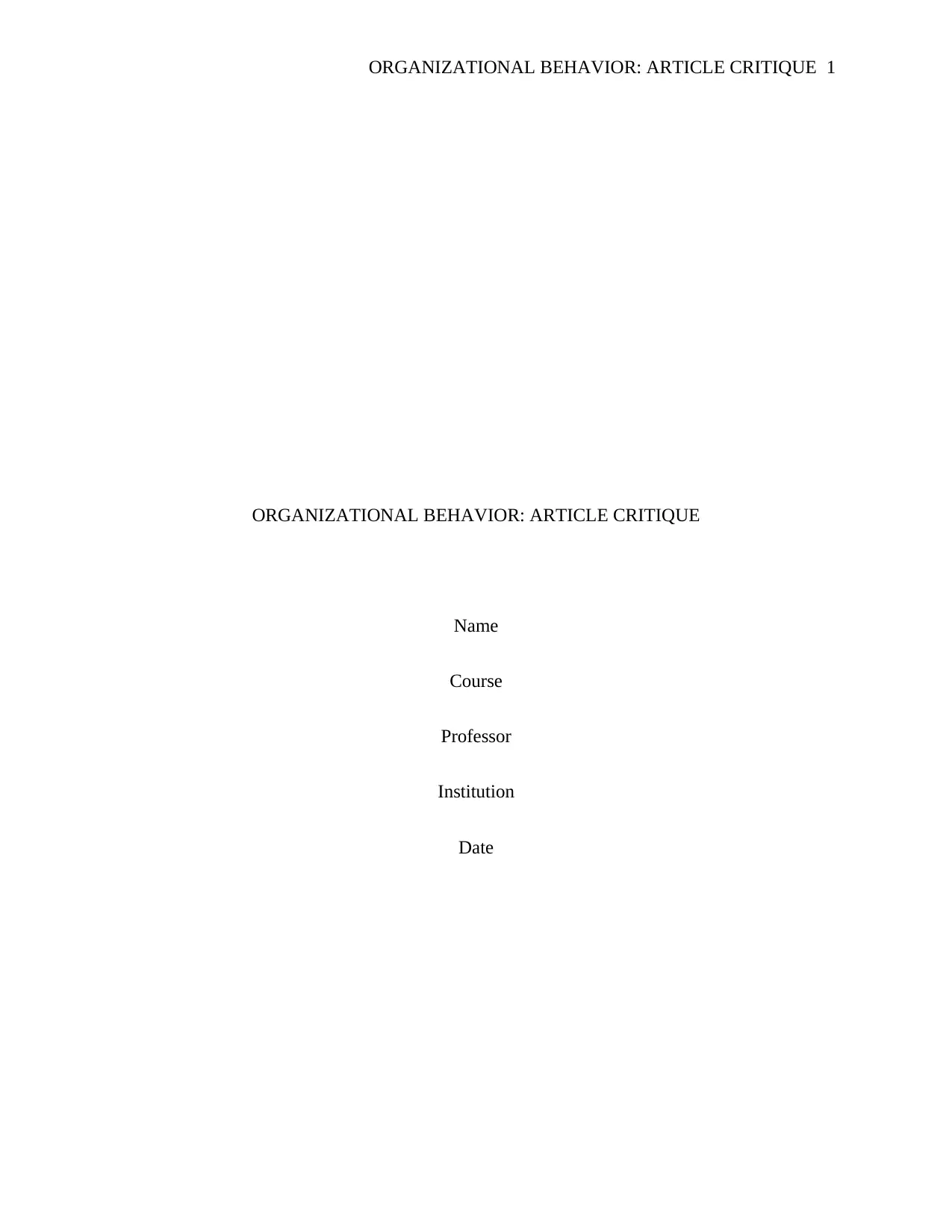
ORGANIZATIONAL BEHAVIOR: ARTICLE CRITIQUE 1
ORGANIZATIONAL BEHAVIOR: ARTICLE CRITIQUE
Name
Course
Professor
Institution
Date
ORGANIZATIONAL BEHAVIOR: ARTICLE CRITIQUE
Name
Course
Professor
Institution
Date
Paraphrase This Document
Need a fresh take? Get an instant paraphrase of this document with our AI Paraphraser
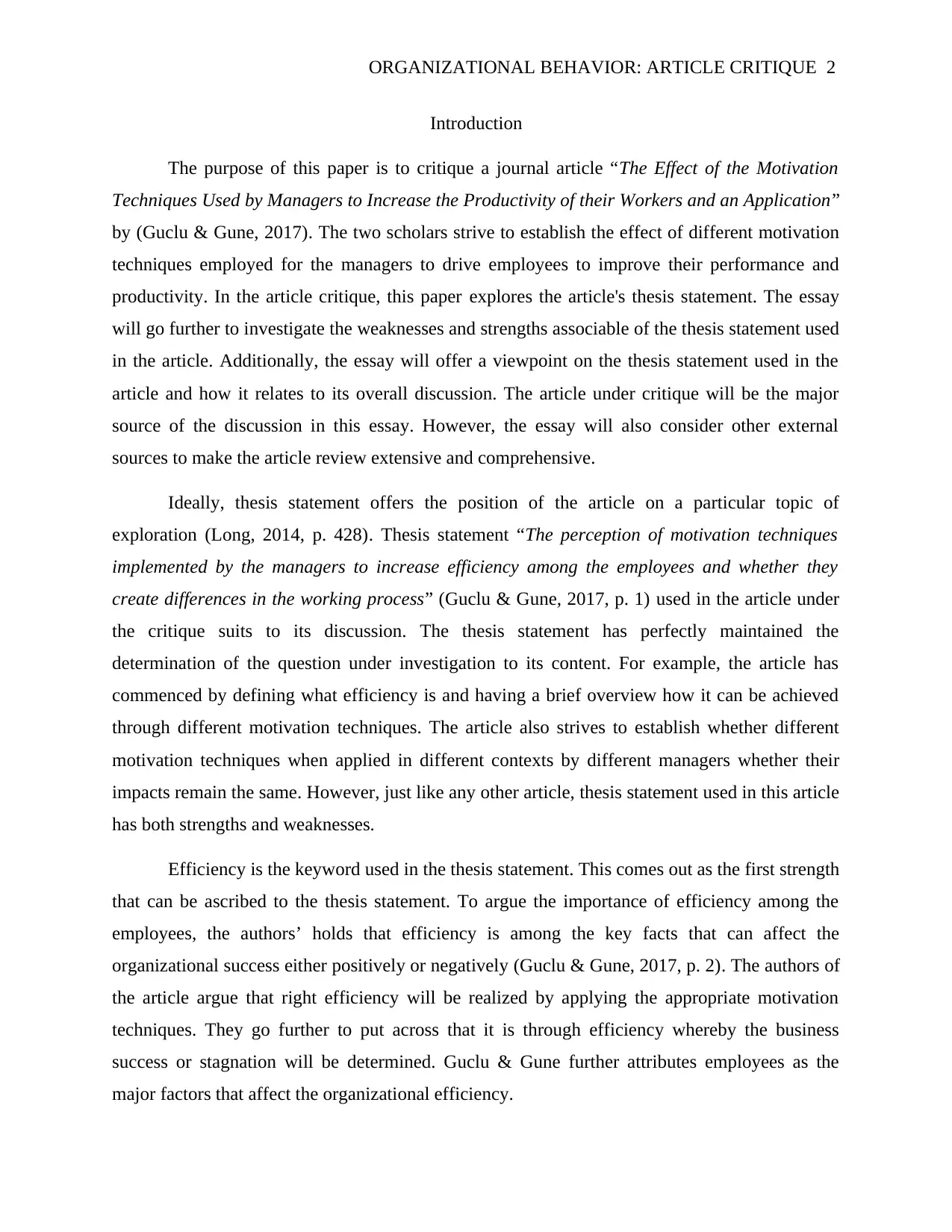
ORGANIZATIONAL BEHAVIOR: ARTICLE CRITIQUE 2
Introduction
The purpose of this paper is to critique a journal article “The Effect of the Motivation
Techniques Used by Managers to Increase the Productivity of their Workers and an Application”
by (Guclu & Gune, 2017). The two scholars strive to establish the effect of different motivation
techniques employed for the managers to drive employees to improve their performance and
productivity. In the article critique, this paper explores the article's thesis statement. The essay
will go further to investigate the weaknesses and strengths associable of the thesis statement used
in the article. Additionally, the essay will offer a viewpoint on the thesis statement used in the
article and how it relates to its overall discussion. The article under critique will be the major
source of the discussion in this essay. However, the essay will also consider other external
sources to make the article review extensive and comprehensive.
Ideally, thesis statement offers the position of the article on a particular topic of
exploration (Long, 2014, p. 428). Thesis statement “The perception of motivation techniques
implemented by the managers to increase efficiency among the employees and whether they
create differences in the working process” (Guclu & Gune, 2017, p. 1) used in the article under
the critique suits to its discussion. The thesis statement has perfectly maintained the
determination of the question under investigation to its content. For example, the article has
commenced by defining what efficiency is and having a brief overview how it can be achieved
through different motivation techniques. The article also strives to establish whether different
motivation techniques when applied in different contexts by different managers whether their
impacts remain the same. However, just like any other article, thesis statement used in this article
has both strengths and weaknesses.
Efficiency is the keyword used in the thesis statement. This comes out as the first strength
that can be ascribed to the thesis statement. To argue the importance of efficiency among the
employees, the authors’ holds that efficiency is among the key facts that can affect the
organizational success either positively or negatively (Guclu & Gune, 2017, p. 2). The authors of
the article argue that right efficiency will be realized by applying the appropriate motivation
techniques. They go further to put across that it is through efficiency whereby the business
success or stagnation will be determined. Guclu & Gune further attributes employees as the
major factors that affect the organizational efficiency.
Introduction
The purpose of this paper is to critique a journal article “The Effect of the Motivation
Techniques Used by Managers to Increase the Productivity of their Workers and an Application”
by (Guclu & Gune, 2017). The two scholars strive to establish the effect of different motivation
techniques employed for the managers to drive employees to improve their performance and
productivity. In the article critique, this paper explores the article's thesis statement. The essay
will go further to investigate the weaknesses and strengths associable of the thesis statement used
in the article. Additionally, the essay will offer a viewpoint on the thesis statement used in the
article and how it relates to its overall discussion. The article under critique will be the major
source of the discussion in this essay. However, the essay will also consider other external
sources to make the article review extensive and comprehensive.
Ideally, thesis statement offers the position of the article on a particular topic of
exploration (Long, 2014, p. 428). Thesis statement “The perception of motivation techniques
implemented by the managers to increase efficiency among the employees and whether they
create differences in the working process” (Guclu & Gune, 2017, p. 1) used in the article under
the critique suits to its discussion. The thesis statement has perfectly maintained the
determination of the question under investigation to its content. For example, the article has
commenced by defining what efficiency is and having a brief overview how it can be achieved
through different motivation techniques. The article also strives to establish whether different
motivation techniques when applied in different contexts by different managers whether their
impacts remain the same. However, just like any other article, thesis statement used in this article
has both strengths and weaknesses.
Efficiency is the keyword used in the thesis statement. This comes out as the first strength
that can be ascribed to the thesis statement. To argue the importance of efficiency among the
employees, the authors’ holds that efficiency is among the key facts that can affect the
organizational success either positively or negatively (Guclu & Gune, 2017, p. 2). The authors of
the article argue that right efficiency will be realized by applying the appropriate motivation
techniques. They go further to put across that it is through efficiency whereby the business
success or stagnation will be determined. Guclu & Gune further attributes employees as the
major factors that affect the organizational efficiency.
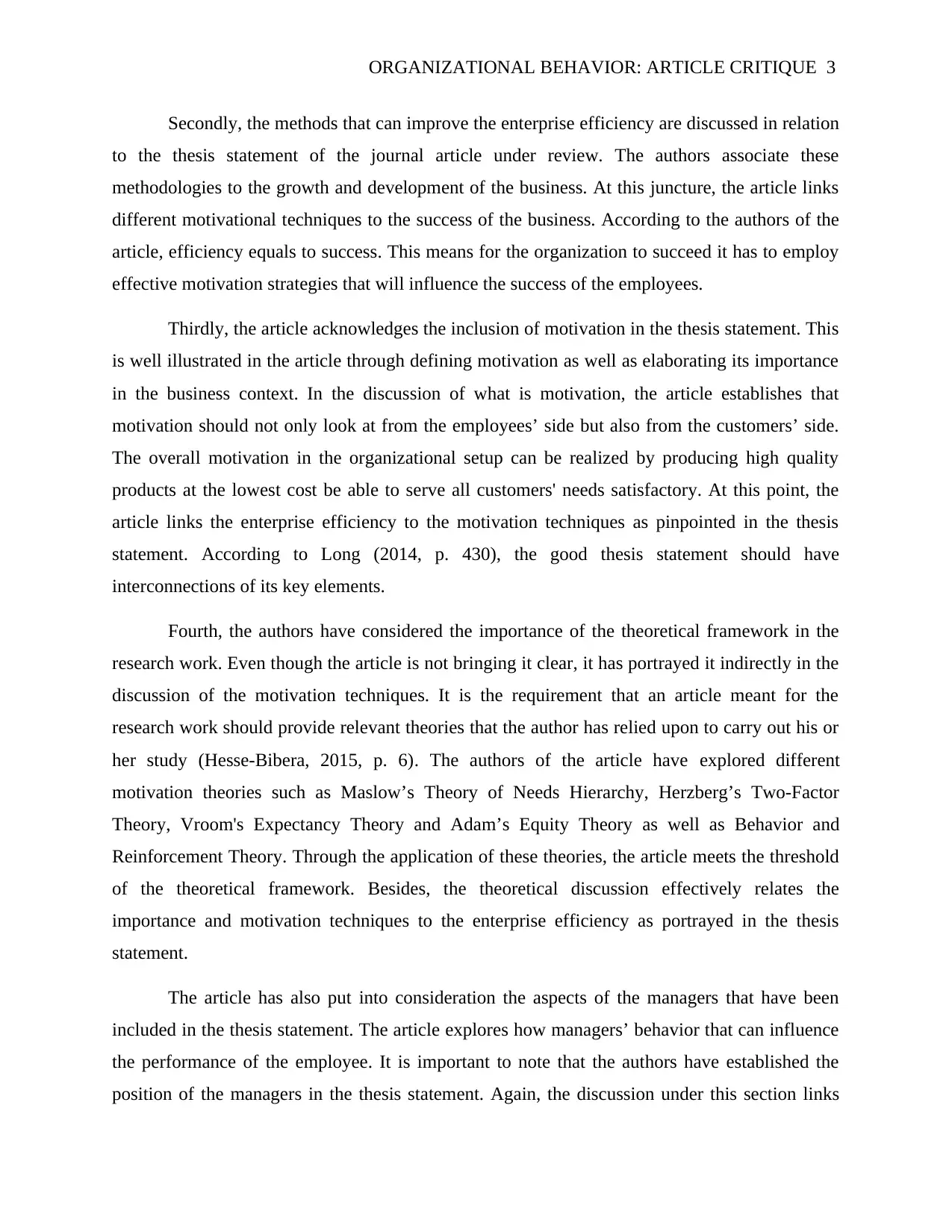
ORGANIZATIONAL BEHAVIOR: ARTICLE CRITIQUE 3
Secondly, the methods that can improve the enterprise efficiency are discussed in relation
to the thesis statement of the journal article under review. The authors associate these
methodologies to the growth and development of the business. At this juncture, the article links
different motivational techniques to the success of the business. According to the authors of the
article, efficiency equals to success. This means for the organization to succeed it has to employ
effective motivation strategies that will influence the success of the employees.
Thirdly, the article acknowledges the inclusion of motivation in the thesis statement. This
is well illustrated in the article through defining motivation as well as elaborating its importance
in the business context. In the discussion of what is motivation, the article establishes that
motivation should not only look at from the employees’ side but also from the customers’ side.
The overall motivation in the organizational setup can be realized by producing high quality
products at the lowest cost be able to serve all customers' needs satisfactory. At this point, the
article links the enterprise efficiency to the motivation techniques as pinpointed in the thesis
statement. According to Long (2014, p. 430), the good thesis statement should have
interconnections of its key elements.
Fourth, the authors have considered the importance of the theoretical framework in the
research work. Even though the article is not bringing it clear, it has portrayed it indirectly in the
discussion of the motivation techniques. It is the requirement that an article meant for the
research work should provide relevant theories that the author has relied upon to carry out his or
her study (Hesse-Bibera, 2015, p. 6). The authors of the article have explored different
motivation theories such as Maslow’s Theory of Needs Hierarchy, Herzberg’s Two-Factor
Theory, Vroom's Expectancy Theory and Adam’s Equity Theory as well as Behavior and
Reinforcement Theory. Through the application of these theories, the article meets the threshold
of the theoretical framework. Besides, the theoretical discussion effectively relates the
importance and motivation techniques to the enterprise efficiency as portrayed in the thesis
statement.
The article has also put into consideration the aspects of the managers that have been
included in the thesis statement. The article explores how managers’ behavior that can influence
the performance of the employee. It is important to note that the authors have established the
position of the managers in the thesis statement. Again, the discussion under this section links
Secondly, the methods that can improve the enterprise efficiency are discussed in relation
to the thesis statement of the journal article under review. The authors associate these
methodologies to the growth and development of the business. At this juncture, the article links
different motivational techniques to the success of the business. According to the authors of the
article, efficiency equals to success. This means for the organization to succeed it has to employ
effective motivation strategies that will influence the success of the employees.
Thirdly, the article acknowledges the inclusion of motivation in the thesis statement. This
is well illustrated in the article through defining motivation as well as elaborating its importance
in the business context. In the discussion of what is motivation, the article establishes that
motivation should not only look at from the employees’ side but also from the customers’ side.
The overall motivation in the organizational setup can be realized by producing high quality
products at the lowest cost be able to serve all customers' needs satisfactory. At this point, the
article links the enterprise efficiency to the motivation techniques as pinpointed in the thesis
statement. According to Long (2014, p. 430), the good thesis statement should have
interconnections of its key elements.
Fourth, the authors have considered the importance of the theoretical framework in the
research work. Even though the article is not bringing it clear, it has portrayed it indirectly in the
discussion of the motivation techniques. It is the requirement that an article meant for the
research work should provide relevant theories that the author has relied upon to carry out his or
her study (Hesse-Bibera, 2015, p. 6). The authors of the article have explored different
motivation theories such as Maslow’s Theory of Needs Hierarchy, Herzberg’s Two-Factor
Theory, Vroom's Expectancy Theory and Adam’s Equity Theory as well as Behavior and
Reinforcement Theory. Through the application of these theories, the article meets the threshold
of the theoretical framework. Besides, the theoretical discussion effectively relates the
importance and motivation techniques to the enterprise efficiency as portrayed in the thesis
statement.
The article has also put into consideration the aspects of the managers that have been
included in the thesis statement. The article explores how managers’ behavior that can influence
the performance of the employee. It is important to note that the authors have established the
position of the managers in the thesis statement. Again, the discussion under this section links
⊘ This is a preview!⊘
Do you want full access?
Subscribe today to unlock all pages.

Trusted by 1+ million students worldwide
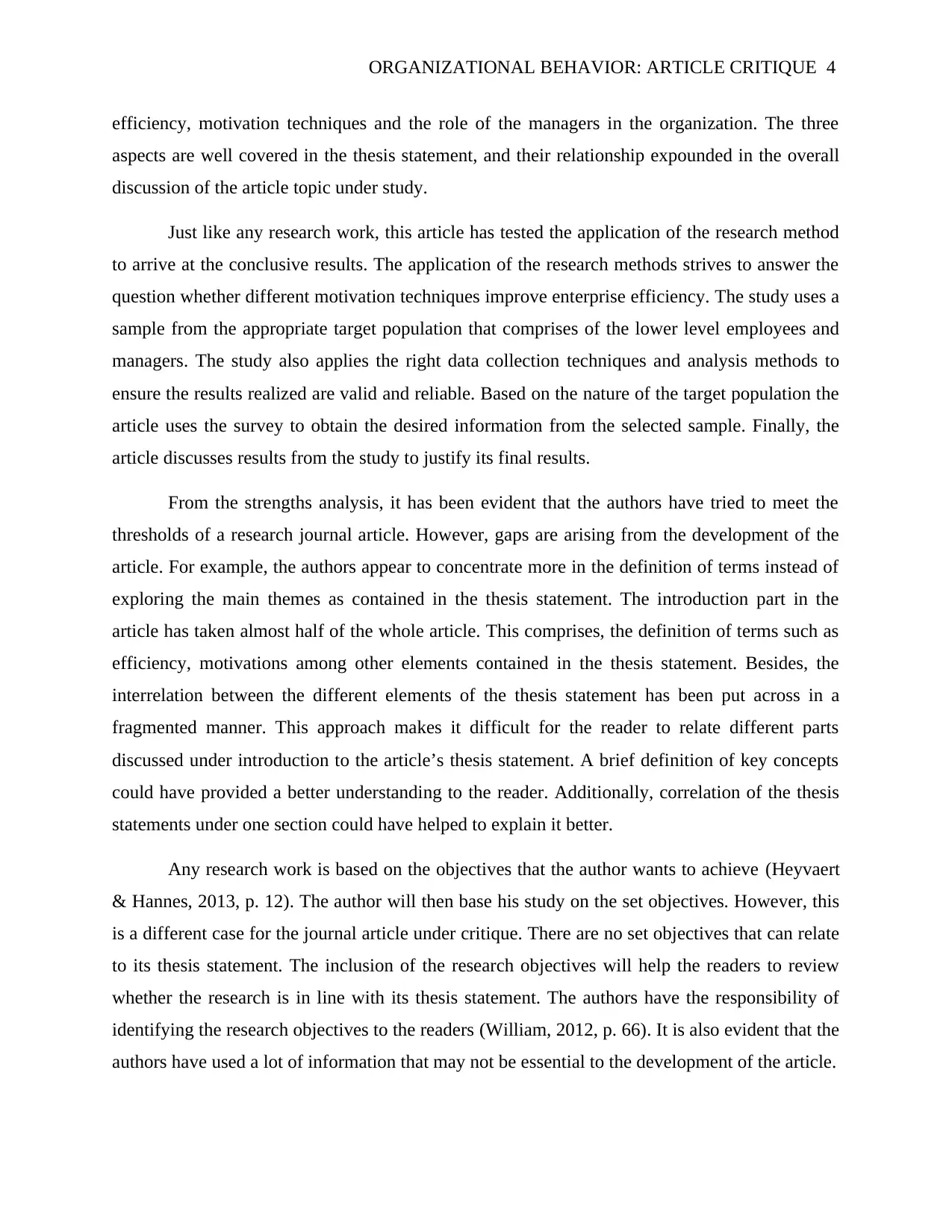
ORGANIZATIONAL BEHAVIOR: ARTICLE CRITIQUE 4
efficiency, motivation techniques and the role of the managers in the organization. The three
aspects are well covered in the thesis statement, and their relationship expounded in the overall
discussion of the article topic under study.
Just like any research work, this article has tested the application of the research method
to arrive at the conclusive results. The application of the research methods strives to answer the
question whether different motivation techniques improve enterprise efficiency. The study uses a
sample from the appropriate target population that comprises of the lower level employees and
managers. The study also applies the right data collection techniques and analysis methods to
ensure the results realized are valid and reliable. Based on the nature of the target population the
article uses the survey to obtain the desired information from the selected sample. Finally, the
article discusses results from the study to justify its final results.
From the strengths analysis, it has been evident that the authors have tried to meet the
thresholds of a research journal article. However, gaps are arising from the development of the
article. For example, the authors appear to concentrate more in the definition of terms instead of
exploring the main themes as contained in the thesis statement. The introduction part in the
article has taken almost half of the whole article. This comprises, the definition of terms such as
efficiency, motivations among other elements contained in the thesis statement. Besides, the
interrelation between the different elements of the thesis statement has been put across in a
fragmented manner. This approach makes it difficult for the reader to relate different parts
discussed under introduction to the article’s thesis statement. A brief definition of key concepts
could have provided a better understanding to the reader. Additionally, correlation of the thesis
statements under one section could have helped to explain it better.
Any research work is based on the objectives that the author wants to achieve (Heyvaert
& Hannes, 2013, p. 12). The author will then base his study on the set objectives. However, this
is a different case for the journal article under critique. There are no set objectives that can relate
to its thesis statement. The inclusion of the research objectives will help the readers to review
whether the research is in line with its thesis statement. The authors have the responsibility of
identifying the research objectives to the readers (William, 2012, p. 66). It is also evident that the
authors have used a lot of information that may not be essential to the development of the article.
efficiency, motivation techniques and the role of the managers in the organization. The three
aspects are well covered in the thesis statement, and their relationship expounded in the overall
discussion of the article topic under study.
Just like any research work, this article has tested the application of the research method
to arrive at the conclusive results. The application of the research methods strives to answer the
question whether different motivation techniques improve enterprise efficiency. The study uses a
sample from the appropriate target population that comprises of the lower level employees and
managers. The study also applies the right data collection techniques and analysis methods to
ensure the results realized are valid and reliable. Based on the nature of the target population the
article uses the survey to obtain the desired information from the selected sample. Finally, the
article discusses results from the study to justify its final results.
From the strengths analysis, it has been evident that the authors have tried to meet the
thresholds of a research journal article. However, gaps are arising from the development of the
article. For example, the authors appear to concentrate more in the definition of terms instead of
exploring the main themes as contained in the thesis statement. The introduction part in the
article has taken almost half of the whole article. This comprises, the definition of terms such as
efficiency, motivations among other elements contained in the thesis statement. Besides, the
interrelation between the different elements of the thesis statement has been put across in a
fragmented manner. This approach makes it difficult for the reader to relate different parts
discussed under introduction to the article’s thesis statement. A brief definition of key concepts
could have provided a better understanding to the reader. Additionally, correlation of the thesis
statements under one section could have helped to explain it better.
Any research work is based on the objectives that the author wants to achieve (Heyvaert
& Hannes, 2013, p. 12). The author will then base his study on the set objectives. However, this
is a different case for the journal article under critique. There are no set objectives that can relate
to its thesis statement. The inclusion of the research objectives will help the readers to review
whether the research is in line with its thesis statement. The authors have the responsibility of
identifying the research objectives to the readers (William, 2012, p. 66). It is also evident that the
authors have used a lot of information that may not be essential to the development of the article.
Paraphrase This Document
Need a fresh take? Get an instant paraphrase of this document with our AI Paraphraser
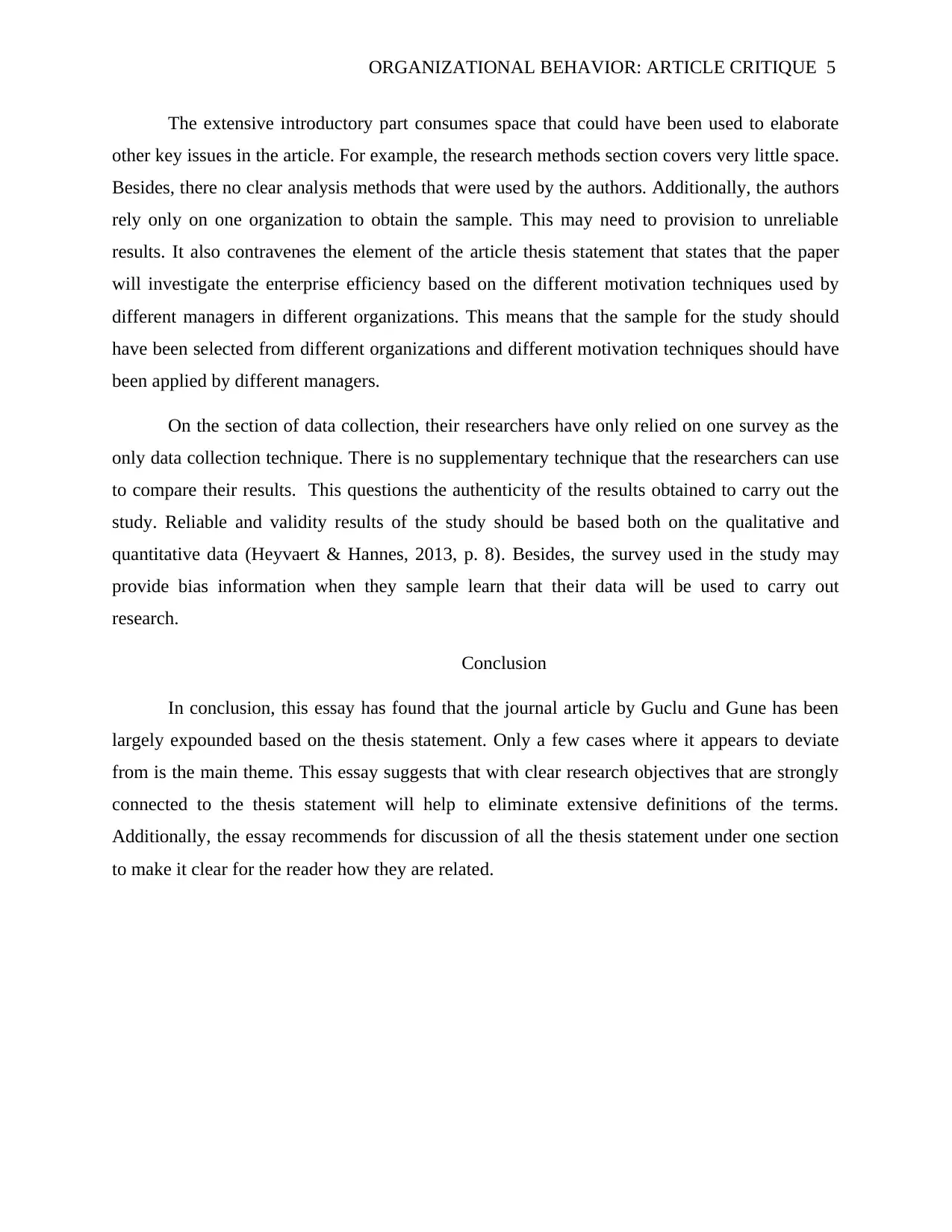
ORGANIZATIONAL BEHAVIOR: ARTICLE CRITIQUE 5
The extensive introductory part consumes space that could have been used to elaborate
other key issues in the article. For example, the research methods section covers very little space.
Besides, there no clear analysis methods that were used by the authors. Additionally, the authors
rely only on one organization to obtain the sample. This may need to provision to unreliable
results. It also contravenes the element of the article thesis statement that states that the paper
will investigate the enterprise efficiency based on the different motivation techniques used by
different managers in different organizations. This means that the sample for the study should
have been selected from different organizations and different motivation techniques should have
been applied by different managers.
On the section of data collection, their researchers have only relied on one survey as the
only data collection technique. There is no supplementary technique that the researchers can use
to compare their results. This questions the authenticity of the results obtained to carry out the
study. Reliable and validity results of the study should be based both on the qualitative and
quantitative data (Heyvaert & Hannes, 2013, p. 8). Besides, the survey used in the study may
provide bias information when they sample learn that their data will be used to carry out
research.
Conclusion
In conclusion, this essay has found that the journal article by Guclu and Gune has been
largely expounded based on the thesis statement. Only a few cases where it appears to deviate
from is the main theme. This essay suggests that with clear research objectives that are strongly
connected to the thesis statement will help to eliminate extensive definitions of the terms.
Additionally, the essay recommends for discussion of all the thesis statement under one section
to make it clear for the reader how they are related.
The extensive introductory part consumes space that could have been used to elaborate
other key issues in the article. For example, the research methods section covers very little space.
Besides, there no clear analysis methods that were used by the authors. Additionally, the authors
rely only on one organization to obtain the sample. This may need to provision to unreliable
results. It also contravenes the element of the article thesis statement that states that the paper
will investigate the enterprise efficiency based on the different motivation techniques used by
different managers in different organizations. This means that the sample for the study should
have been selected from different organizations and different motivation techniques should have
been applied by different managers.
On the section of data collection, their researchers have only relied on one survey as the
only data collection technique. There is no supplementary technique that the researchers can use
to compare their results. This questions the authenticity of the results obtained to carry out the
study. Reliable and validity results of the study should be based both on the qualitative and
quantitative data (Heyvaert & Hannes, 2013, p. 8). Besides, the survey used in the study may
provide bias information when they sample learn that their data will be used to carry out
research.
Conclusion
In conclusion, this essay has found that the journal article by Guclu and Gune has been
largely expounded based on the thesis statement. Only a few cases where it appears to deviate
from is the main theme. This essay suggests that with clear research objectives that are strongly
connected to the thesis statement will help to eliminate extensive definitions of the terms.
Additionally, the essay recommends for discussion of all the thesis statement under one section
to make it clear for the reader how they are related.
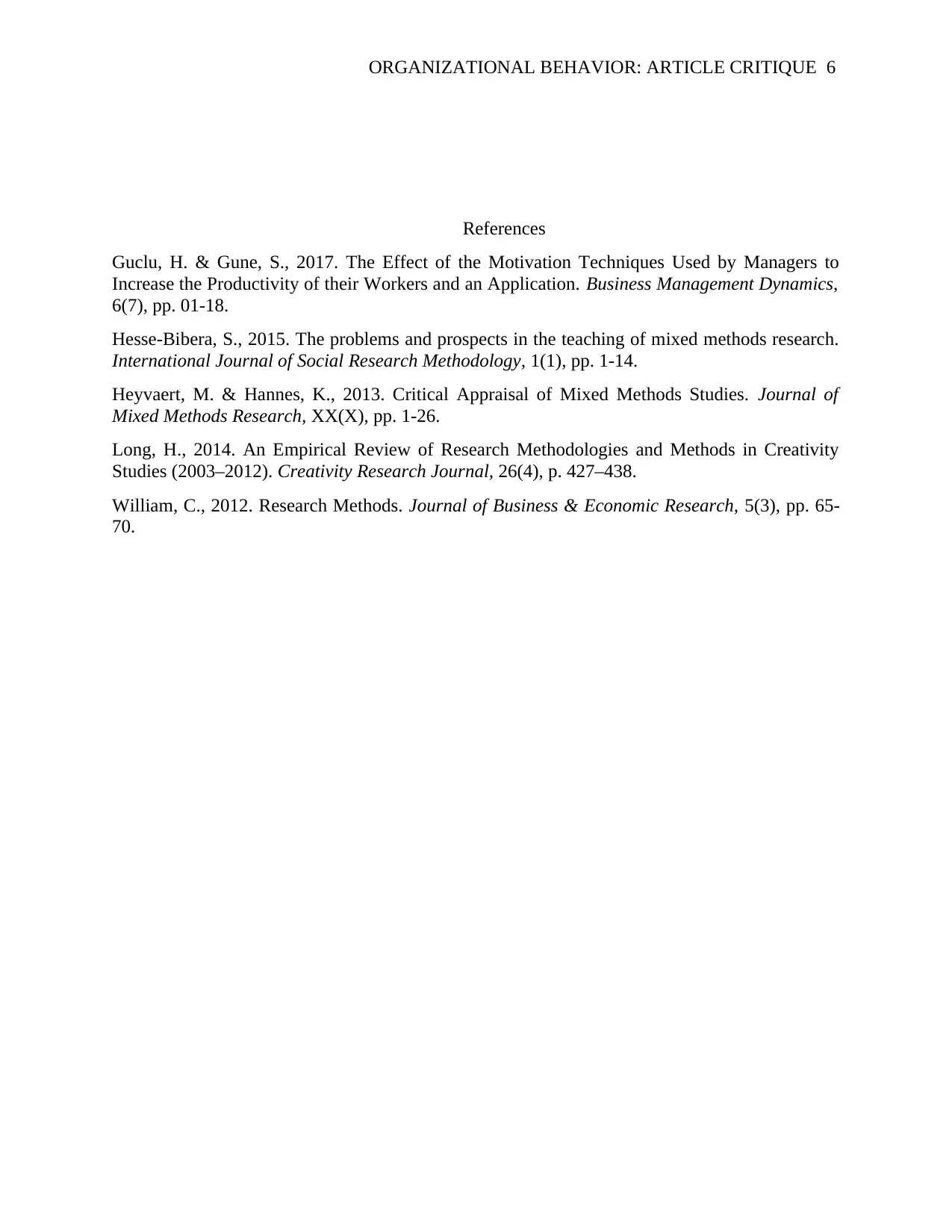
ORGANIZATIONAL BEHAVIOR: ARTICLE CRITIQUE 6
References
Guclu, H. & Gune, S., 2017. The Effect of the Motivation Techniques Used by Managers to
Increase the Productivity of their Workers and an Application. Business Management Dynamics,
6(7), pp. 01-18.
Hesse-Bibera, S., 2015. The problems and prospects in the teaching of mixed methods research.
International Journal of Social Research Methodology, 1(1), pp. 1-14.
Heyvaert, M. & Hannes, K., 2013. Critical Appraisal of Mixed Methods Studies. Journal of
Mixed Methods Research, XX(X), pp. 1-26.
Long, H., 2014. An Empirical Review of Research Methodologies and Methods in Creativity
Studies (2003–2012). Creativity Research Journal, 26(4), p. 427–438.
William, C., 2012. Research Methods. Journal of Business & Economic Research, 5(3), pp. 65-
70.
References
Guclu, H. & Gune, S., 2017. The Effect of the Motivation Techniques Used by Managers to
Increase the Productivity of their Workers and an Application. Business Management Dynamics,
6(7), pp. 01-18.
Hesse-Bibera, S., 2015. The problems and prospects in the teaching of mixed methods research.
International Journal of Social Research Methodology, 1(1), pp. 1-14.
Heyvaert, M. & Hannes, K., 2013. Critical Appraisal of Mixed Methods Studies. Journal of
Mixed Methods Research, XX(X), pp. 1-26.
Long, H., 2014. An Empirical Review of Research Methodologies and Methods in Creativity
Studies (2003–2012). Creativity Research Journal, 26(4), p. 427–438.
William, C., 2012. Research Methods. Journal of Business & Economic Research, 5(3), pp. 65-
70.
⊘ This is a preview!⊘
Do you want full access?
Subscribe today to unlock all pages.

Trusted by 1+ million students worldwide
1 out of 6
Related Documents
Your All-in-One AI-Powered Toolkit for Academic Success.
+13062052269
info@desklib.com
Available 24*7 on WhatsApp / Email
![[object Object]](/_next/static/media/star-bottom.7253800d.svg)
Unlock your academic potential
Copyright © 2020–2025 A2Z Services. All Rights Reserved. Developed and managed by ZUCOL.





